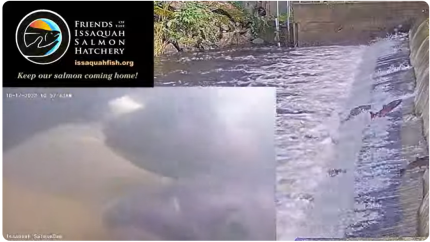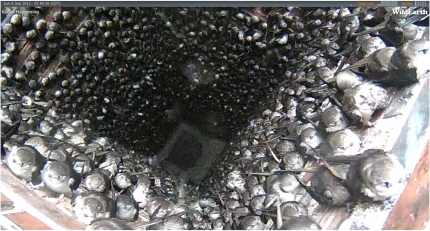Live fish and wildlife cameras connect people to nature in a fun and accessible way! Viewing fish and wildlife through a free online platform allows people to experience species that they may otherwise never observe in the wild. WDFW is proud to support and promote community organizations who manage these cameras and support Washington’s fish and wildlife through their conservation and engagement efforts.
Hood Canal steelhead cam
These steelhead are part of a conservation program managed by Long Live the Kings to support the recovery of Hood Canal’s native steelhead. Hatched from wild-spawned eggs, they are being raised at the west side of Hood Canal to help give natural populations a boost. When they mature, they are released to spawn in the rivers and migrate to sea. Watch a video of past steelhead releases.
Thanks in part to a WDFW Watchable Wildlife grant, this camera from our partners at Long Live the Kings shows an up-close glimpse into the lives of Hood Canal steelhead. Long Live the Kings is a Seattle-based nonprofit organization dedicated to restoring wild salmon and steelhead and supporting sustainable fishing.
Issaquah salmon cam

Coho and Chinook salmon return from their two to five year stays in the Pacific Ocean to the place they were born – in this case, the Issaquah Salmon Hatchery, one of WDFW's most-visited hatcheries. Salmon begin their lives in streams and make their way to the ocean where they stay for several years. They later return to their stream of birth to lay and fertilize their eggs in a process called spawning. At Issaquah Creek, their path upstream is blocked by a weir (the dam the salmon are trying to jump), and they are re-directed up a fish ladder (not visible in video), rather than continuing up the creek to spawn. At the top of the fish ladder, the eggs and sperm (called milt) will be collected, and salmon will be raised in the fish hatchery until they migrate to the ocean to repeat this cycle.
Led by our partners at the Friends of Issaquah Hatchery (FISH), this fish cam provides viewers a unique opportunity to view fish at WDFW’s Issaquah Hatchery. FISH is an Issaquah-based nonprofit committed to protecting salmon and ensuring their survival for future generations through education, advocacy, and outreach.
Part of the funding for this camera set-up comes from the Puget Sound Recreational Fisheries Enhancement Fund (PSRFEF). PSRFEF is supported by a portion of the sales from the marine/combination fishing license. FISH also thanks the King County Flood Control District and the Watershed Resource Inventory Area 8 for the grants that make this service available.
Vaux’s (chimney) swifts at the Wagner Center Chimney in Monroe

Vaux’s swifts are small birds that roost in hollowed-out old growth trees; however, with fewer old growth trees available, they have taken to roosting in human-made chimneys. The Frank Wagner Elementary School chimney in Monroe is a critical migratory stopover for swifts, hosting more than 20,000 swifts on its busiest nights.
Vaux’s swifts migrate twice per year in Washington. During spring, migration runs from mid-April through the end of May. In fall, migration runs from about mid-August through mid-September.
Watch these birds enter and roost in the Wagner Center chimney! Streaming views inside and outside the chimney are courtesy of the Pilchuck Audubon Society.